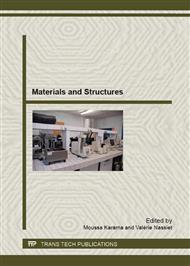p.1
p.9
p.17
p.25
p.33
p.41
p.49
p.57
Mechanical Behavior of a Sandwich Composite with Cardboard Core Reinforced Fabric
Abstract:
A sandwich structure is obtained from two skins or soles, with good mechanical characteristics, bonded to a core made of a lightweight material of low resistance. Glued to a core made of a lightweight material of low resistance. The strength and modulus of elasticity of the skin condition the bending behavior of a sandwich. Bending, the skins of the sandwich are solicited in traction and in compression, while the core is subjected to shear. Our study focuses on the experimental characterization under flexural load of new composite sandwich combined. The sandwich proposed constituted of two skins armed by metal grids impregnated with epoxy matrix type STR and souls composed of hybrid corrugated cardboard reinforced by fabric. Several configurations of souls made from cardboard cellulosic and fabrics were taken into account. An experimental and numerical investigation is conducted to analyze the behavior of these structures. The results show that the failure mode is strongly influenced by the stacking sequence considered.
Info:
Periodical:
Pages:
9-16
Citation:
Online since:
April 2013
Authors:
Keywords:
Price:
Сopyright:
© 2013 Trans Tech Publications Ltd. All Rights Reserved
Share:
Citation:


